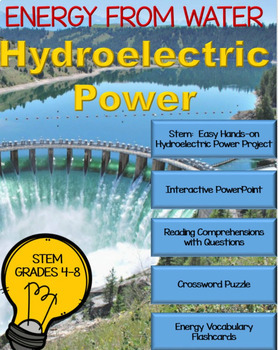Energy: Hydroelectric Power with STEM Project
- Zip
Also included in
- This bundle contains NGSS aligned lessons on three sources of renewable energy: Wind Energy, Solar Energy and Hydroelectric Energy. They are aligned with the following performance expectations: NGSS 4-ESS3-1, 4-PS3-4, 5-ESS3-1. Product Descriptions:Using Windmills to Change Wind Energy to ElectriciPrice $17.00Original Price $21.25Save $4.25
Description
This Hydroelectric Energy package shows how hydroelectric energy is produced and the energy transformations that happen to turn power from water into electricity.
The package includes an interactive PowerPoint presentation which shows how hydroelectric power is produced and discusses the advantages and disadvantages of hydro power.
The presentation makes liberal use of diagrams and pictures to illustrate the points simply and clearly. This presentation is suitable for multiple grade levels.
The package also includes two hydro power reading comprehension articles, a hydro energy vocabulary sheet, a crossword puzzle, and a simple lab which can be done with readily available materials.
This package covers, in a simple, straightforward way, what is needed to make electricity from water power, how we produce hydroelectric, and hydro energy’s environmental benefits and challenges. These materials are aligned with Common Core, and Next Generation Science Standards (NGSS) and follow the 5E method as well.
==================================================================================
What you will get in this package:
Engagement
A Set of engagement questions to create interest and draw out students’ prior knowledge and conceptions.
Explanation
A PowerPoint presentation on hydroelectric energy
Two reading comprehension exercises with answer keys
Elaboration
A vocabulary list with definitions
A vocabulary cross word puzzle
Evaluation
Assessment questions on the reading exercises with answer key
Exploration
A PowerPoint giving instructions and illustrations for the lab exercise
An extension question at the end of each reading which the teacher can assign individually, to small groups or as a class exercise to explore and report on additional hydroelectric related topics and issues at the teacher’s discretion.
==================================================================================
==================================================================================
You may also be interested in these additional energy and science related products:
Using Windmills to Change Wind Energy to Electricity
Back to School Bubblegum Science Lab
Using Wind Energy to Generate Electricity – A STEM Project
STEM Engineering Challenge – Lost on Bigfoot Mountain
Generating Electricity with Wind Energy
Force and Motion PowerPoint Game
Solar Energy - Energy Transformation How We Use Energy from The Sun
Motion Graphing Printable Worksheets
My Favorite Cookies – A Microsoft EXCEL Project
Nuclear Energy How Nuclear Power is Transformed into Electricity






